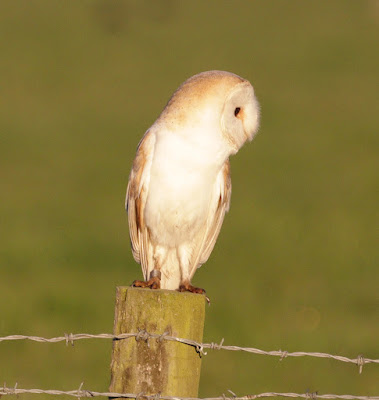When I spoke to Andy a day or two ago he told me of two nests in man-made nest boxes, a Barn Owl and a Kestrel. The Barn Owls had produced eight eggs and also a pair of Kestrel sitting on five eggs. Both boxes have remote cameras so as to monitor the timing and extent of any breeding attempts and to minimise visits.
We can inspect the Kestrels under a general Ringing Licence, but for visits to Barn Owls we must have our Schedule One Licenses to hand, permits which also cover other species in our geographical area - Cetti’s Warbler, Little Ringed Plover, Kingfisher and Avocet.
For the interest of readers I reproduce here just a few of the many conditions attached to having a permit to disturb nesting birds.
• "While engaged in work permitted by this Permit the Permit holder shall carry a copy of the Permit and produce it to any Police Officer or any Country Agency officer on demand
• Permit holders are expected to exercise the utmost care to avoid undue disturbance to wild birds, and in particular to avoid any action which might endanger breeding success. Failure to do so may result in revocation of the Permit.
• Any wild bird taken under this Permit shall be liberated at the site of capture immediately after examination and/or ringing or marking
• The Permit holder should contact the landowner prior to exercising this licence in order to avoid duplication and minimise disturbance to Schedule 1 birds.
• Eggs or chicks may be handled (by ringers) or moved (by nest recorders) for brief nest examination purposes only. Any chicks or eggs must be returned to the nest immediately after examination unless the eggs are addled or from nests which are known to have been deserted."
I was on the way to Cockerham this morning when I stopped on Stalmine Moss to watch another Barn Owl. This one clearly had young to feed as it was hunting at 0600 and still at it when I returned the same way.
Barn Owl
At one point the owl dived into the grass and caught something very small, so tiny it was probably not even a mammal, and then flew immediately into a nearby building. Ten minutes later it was back and allowed some fair distance photography. Clearly, this is an owl on a mission to feed both youngsters and a partner.
Barn Owl
Barn Owl
Barn Owl
Barn Owl
Barn Owl
Spending time with the Barn Owl rather delayed my visit to Conder Green where the water levels are very low following three weeks with almost zero rain.
Conder Green
Tufted Ducks
There was little to add to the visit of Friday last but some joy in discovering four singing Reed Buntings, a shy bird that is easily missed. And at last a number of Swifts fed over the hawthorn hedgerows, twenty or more in total.
The small nesting platform is rather crowded with single pairs of Black-headed Gull, Oystercatcher and Common Tern vying for space and where one or more may lose out come hatching time.
Maybe the Common Tern I saw circling the basin at Glasson Dock is one of the returning pair that laid eggs here in 2018 but failed to progress. Worth keeping an eye open.
Glasson, Near Lancaster City
Common Tern



































































.jpg)














